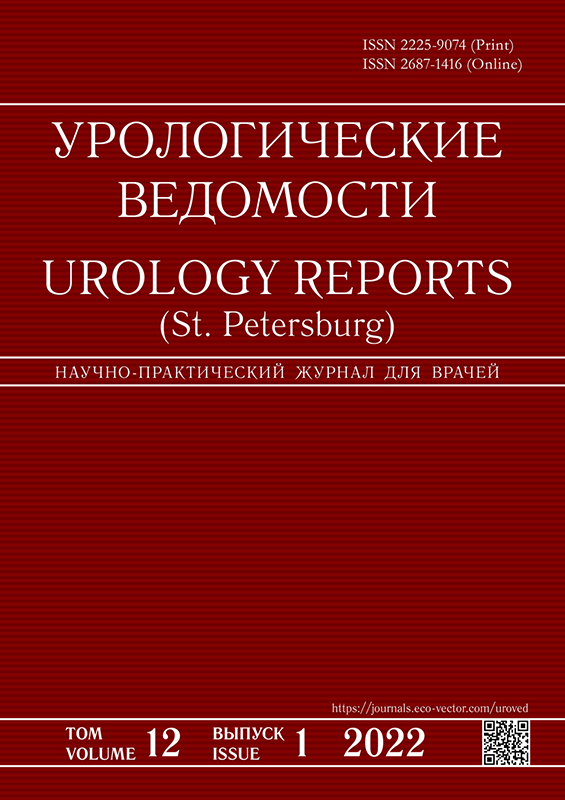Choice of access for endoscopic treatment of patients with proximal ureter calculi. Our experience
- 作者: Topuzov M.E.1, Basok S.M.1, Kustov P.V.1, Abinov O.A.1
-
隶属关系:
- North-Western State Medical University named after I.I. Mechnikov
- 期: 卷 12, 编号 1 (2022)
- 页面: 49-54
- 栏目: Original study
- ##submission.dateSubmitted##: 21.12.2021
- ##submission.dateAccepted##: 30.03.2022
- ##submission.datePublished##: 26.04.2022
- URL: https://journals.eco-vector.com/uroved/article/view/90771
- DOI: https://doi.org/10.17816/uroved90771
- ID: 90771
如何引用文章
详细
BACKGROUND: Urolithiasis is an actual problem of urology. Over the past 20 years, the tactics of treating patients with urolithiasis has changed significantly. However, there are currently no standardized algorithms for choosing the most effective treatment for a particular patient.
AIM: To evaluate the efficacy and safety of using a mininephroscope in comparison with the use of a flexible ureterorenoscope when performing percutaneous antegrade ureterolithotripsy in the treatment of patients with proximal ureteral calculi.
MATERIALS AND METHODS: A retrospective analysis of case histories of 61 patients with calculi in the proximal ureter was performed. All patients for surgical treatment were hospitalized in a planned manner with a previously installed nephrostomy drain 12Ch. All patients underwent percutaneous antegrade ureterolithotripsy – 15 using a mininephroscope (Group 1) and 46 using a flexible ureterorenoscope (Group 2).
RESULTS: The clinical performance of the mininephroscope and the flexible ureterorenoscope for ureterolithotripsy is similar. In patients of the 1st and 2nd groups, the average duration of the operation (59 ± 10 min and 63 ± 9 min, respectively, p > 0.1) and the Stone Free Rate (SFR) on the first day after surgery (respectively 93.3% and 95.7%) did not significantly differ. There were no intraoperative complications in any of the patients. The frequency of postoperative complications in patients of the 1st and 2nd groups was low, all complications corresponded to the 1st degree according to the Clavien–Dindo classification. The duration of postoperative hospital stay in patients of the 1st and 2nd groups was the same and averaged 3 days.
CONCLUSIONS: Performing percutaneous antegrade ureterolithotripsy using a nephroscope and a flexible ureterorenoscope ensures the achievement of SFR in the same short time, the minimum duration of surgery and the duration of the postoperative bed-day, as well as a low incidence of postoperative complications.
全文:
作者简介
Marlen Topuzov
North-Western State Medical University named after I.I. Mechnikov
Email: martop@mail.ru
ORCID iD: 0000-0001-7765-0122
SPIN 代码: 3061-6420
Scopus 作者 ID: 23979017100
Dr. Sci. (Med), Professor of the Department of Urology
俄罗斯联邦, 41, Kirochnaya st., Saint Petersburg, 191015Stanislav Basok
North-Western State Medical University named after I.I. Mechnikov
Email: stas_basok@mail.ru
ORCID iD: 0000-0003-2173-7485
SPIN 代码: 7142-8167
Urologist of the Peter the Great Clinic
俄罗斯联邦, 41, Kirochnaya st., Saint Petersburg, 191015Petr Kustov
North-Western State Medical University named after I.I. Mechnikov
Email: wisttut@gmail.com
ORCID iD: 0000-0002-4075-3205
Postgraduate student
俄罗斯联邦, 41, Kirochnaya st., Saint Petersburg, 191015Osman Abinov
North-Western State Medical University named after I.I. Mechnikov
编辑信件的主要联系方式.
Email: osmanabinov1111@mail.ru
ORCID iD: 0000-0003-1510-7612
SPIN 代码: 2285-5446
Clinical Resident of the Department of Urology
俄罗斯联邦, 41, Kirochnaya st., Saint Petersburg, 191015参考
- Scales CD Jr, Smith AC, Hanley JM, Saigal CS; Prevalence of kidney stones in the United States. Eur Urol. 2012;62(1):160–165. doi: 10.1016/j.eururo.2012.03.052
- Kaprin AD, Apolihin OI, Sivkov AV, et al. The analysis of uronephrologic morbidity and mortality in russian federation during the period of 2002–2014 according to the official statistics. Experimental and clinical urology. 2016;(3):4–13. (In Russ.)
- Apolikhin OI, Sivkov AV, Solntseva TV, et al. Ehpidemiologiya MKB v razlichnykh regionakh RF po dannym ofitsial’noi statistiki. Proceedings of the Russian Scientific Conference with international participation “Mochekamennaya bolezn’: fundamental’nye issledovaniya, innovatsii v diagnostike i lechenii”. Saratov Journal of Medical Scientific Research. 2011;7(2 suppl):120. (In Russ.)
- Glybochko PV, Lopatkin NA, Alyaev YuG, Akhvlediani ND. Diagnostika i lechenie mochekamennoi bolezni. Chto izmenilos’ za poslednie 20 let? Saratov Journal of Medical Scientific Research. 2011;7(2 suppl):9–12. (In Russ.)
- Marickar YM, Vijay A. Female stone disease: the changing trend. Urol Res. 2009;37:337–340. doi: 10.1007/s00240-009-0216-2
- Gu XJ, Lu JL, Xu Y. Treatment of large impacted proximal ureteral stones: randomized comparison of minimally invasive percutaneous antegrade ureterolithotripsy versus retrograde ureterolithotripsy. World J Urol. 2013;31:1605–1610. doi: 10.1007/s00345-013-1026-2
- Elgebaly O, Abdeldayem H, Idris F, et al. Antegrade mini-percutaneous flexible ureteroscopy versus retrograde ureteroscopy for treating impacted proximal ureteric stones of 1–2 cm: A prospective randomised study. Arab J Urol. 2020;18(3):176–180. doi: 10.1080/2090598X.2020
补充文件






